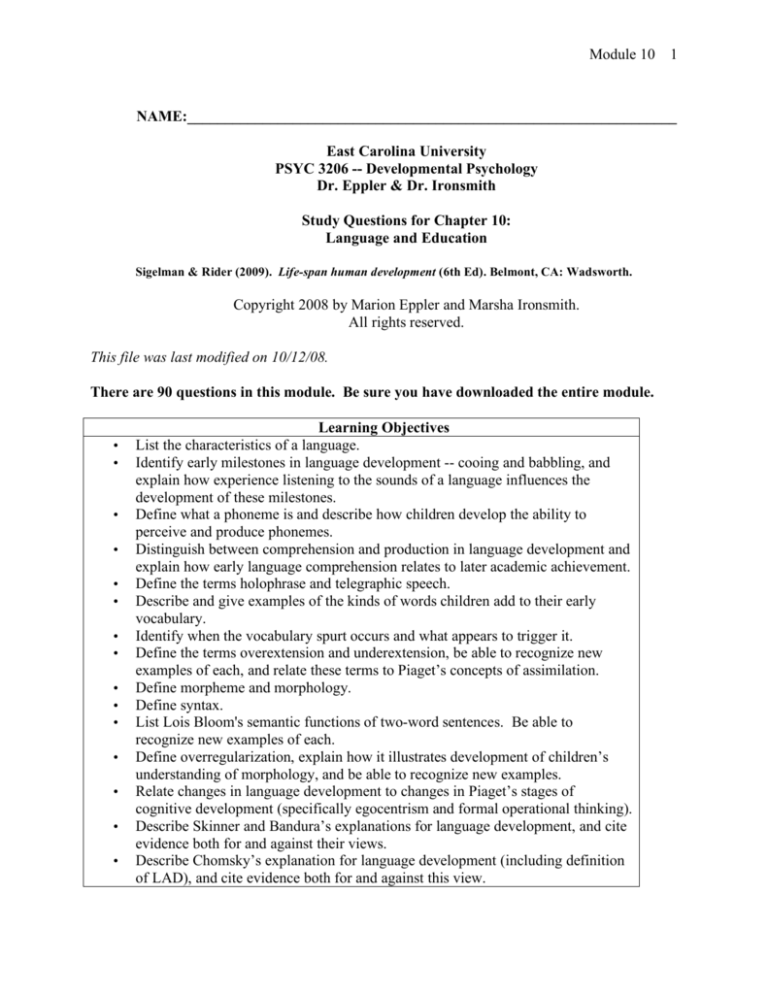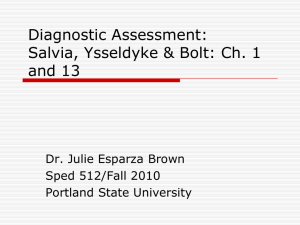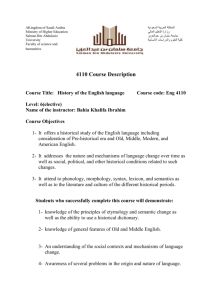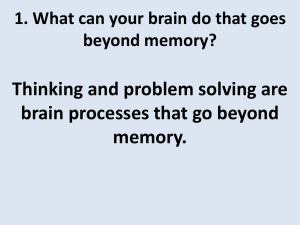
Module 10
1
NAME:_________________________________________________________________
East Carolina University
PSYC 3206 -- Developmental Psychology
Dr. Eppler & Dr. Ironsmith
Study Questions for Chapter 10:
Language and Education
Sigelman & Rider (2009). Life-span human development (6th Ed). Belmont, CA: Wadsworth.
Copyright 2008 by Marion Eppler and Marsha Ironsmith.
All rights reserved.
This file was last modified on 10/12/08.
There are 90 questions in this module. Be sure you have downloaded the entire module.
•
•
•
•
•
•
•
•
•
•
•
•
•
•
•
Learning Objectives
List the characteristics of a language.
Identify early milestones in language development -- cooing and babbling, and
explain how experience listening to the sounds of a language influences the
development of these milestones.
Define what a phoneme is and describe how children develop the ability to
perceive and produce phonemes.
Distinguish between comprehension and production in language development and
explain how early language comprehension relates to later academic achievement.
Define the terms holophrase and telegraphic speech.
Describe and give examples of the kinds of words children add to their early
vocabulary.
Identify when the vocabulary spurt occurs and what appears to trigger it.
Define the terms overextension and underextension, be able to recognize new
examples of each, and relate these terms to Piaget’s concepts of assimilation.
Define morpheme and morphology.
Define syntax.
List Lois Bloom's semantic functions of two-word sentences. Be able to
recognize new examples of each.
Define overregularization, explain how it illustrates development of children’s
understanding of morphology, and be able to recognize new examples.
Relate changes in language development to changes in Piaget’s stages of
cognitive development (specifically egocentrism and formal operational thinking).
Describe Skinner and Bandura’s explanations for language development, and cite
evidence both for and against their views.
Describe Chomsky’s explanation for language development (including definition
of LAD), and cite evidence both for and against this view.
Module 10
•
•
•
•
•
•
•
•
•
•
•
2
Know which aspects of language development each of these views best explains
(phonology, morphology, syntax, semantics, pragmatics).
Identify where each of these views stands on the nature/nurture issue.
Describe the interactionist view of language development, and explain how it
relates to Piaget's and to Vygotsky’s theoretical views.
Define child directed speech and explain its role in language development.
Cite evidence for a sensitive period in language development.
Describe similarities between language development in deaf (learning ASL) and
hearing children. Discuss the advantage to deaf children of learning ASL early in
life.
When you are done with this section: Be able to define the terms phonology,
morphology, syntax, semantics, and pragmatics, and be able to recognize new
examples of each.
Define the alphabetic principle and phonological awareness, explain the role
phonological awareness plays in learning how to read.
Define emergent literacy and give examples of how parents can promote it.
List the characteristics of skill readers. Describe how dyslexia is related to
phonological awareness.
Understand how the phonics and whole language approaches differ, and know
which is more effective in teaching children how to read.
Mastering Language
What Must Be Mastered
1. Language is familiar to us yet difficult to define. We talk about body language and computer
languages. However most linguists would agree with the definition your text provides. This
includes three things. List them:
2. The last part of the definition refers to what linguists call the "generativity" of language. This
means that you can use language to produce an infinite number of things to say which you have
never heard anybody else say, have never said before and may wish you hadn't said and never
want to say again! In any case, this means that language is a creative or ______________
ability.
The Course of Language Development
Before the First Words
Module 10
NOTE: What we're talking about here is the development of language SOUNDS. These
individual sounds of language are called ___________. Therefore, this is referred to as:
PHONOLOGY. PHONE = SOUND; OLOGY = KNOWLEDGE OF
3. Return to Chapter 6. Briefly summarize what you already know about infants' ability to
perceive phonemes.
4. Critical Thinking Question: What does this information suggest about the nature/nurture
question with relation to language development?
5. Define cooing and describe its development.
6. Define babbling and describe its development.
7. Cooing and babbling are examples of Piaget’s ______________ circular reactions.
8. Explain how experience listening to the sounds of a language influences the development of
babbling.
9. (True or False- if False, explain why it's false.) Deaf infants’ babbling sounds very much like
hearing infants’ babbling up to about the age of 6 months.
3
Module 10
4
10. (True or False- if False, explain why it's false.) Experience influences the development of
babbling starting around the age of 2 months.
11. List three changes in babbling that occur around the age of 8 months that reflect the influence
of experience hearing a particular language being spoken.
12. The meaning of language is referred to as _____________. When children learn the meaning
of words, they are mastering ___________.
13. Comprehension (or receptive language) refers to
while Production (or expressive language) refers to
14. A 10-month-old may not be able to say any words yet but he may be able to comprehend as
many as ________ words. Thus, his comprehension is (better than, worse than) his production.
15. How is early language comprehension related to later academic achievement?
16. How do children first learn word meaning?
The First Words
17. Holophrases refer to:
18. Why are infants’ first words called holophrases?
19. According to Katherine Nelson's research, what kinds of words do children add to their
vocabulary at first?
Module 10
5
20. Children typically experience a dramatic vocabulary growth spurt at around age
______________ months.
21. Vocabulary growth is generally slow for the first few months, but then there is a dramatic
growth in language production at around age 18 to 24 months. What seems to trigger this
dramatic increase in vocabulary?
22. Critical Thinking Question: How does the timing of this vocabulary spurt relate to
cognitive development (Piaget’s stages)?
23. Young children often make the mistake of using a word to refer to too broad a range of
objects, which is called ______________, or they use a word to refer to too narrow a range of
objects, which is called ______________.
HINT: It may be easier to remember these two words and what they mean if you break each one
down. Overextension -- over + extend = go too far and apply a label to extra things.
Underextension -- under + extend = don’t go far enough and apply a label to too few things
24. Calling all four-legged animals "doggie" is an example of ______________, while referring
to only your family pet as "doggie" is an example of ______________.
25. Overextension is an example of Piaget’s concept of ______________.
26. Critical Thinking Question: How do children’s overextension errors illustrate the concept
discussed earlier of comprehension preceding production?
NOTE: Just as the individual units of sound are called phonemes, the individual units of
meaning are referred to as ____________. Knowledge of this is then referred to as
MORPHOLOGY. Knowing that adding an "s" to "duck" makes it a plural word, "ducks" is an
example of morphology.
Telegraphic Speech
Module 10
6
27. Children move from holophrases to simple two-word sentence combinations, called
______________, at around age 2 years.
28. In what sense can early two-word speech be described as telegraphic?
29. When a child begins to combine words into sentences, he is developing an understanding of
____________. Give an example of syntax.
30. The purpose of putting words into sentences is to express meaning or __________. Lois
Bloom talks about a ____________ ___________ which emphasizes:
31. What are the semantic functions that children can express in two-word sentences? Give some
examples of each.
32. Around age 3, children typically make consistent language errors such as "I have two foots."
and "He goed home." These kinds of errors are referred to as ______________.
33. Explain how these errors are actually evidence that children are developing a more complex
understanding of language rules.
HINT: Break the word down to make it easier to remember. Overregularization -- over + regular
+ ize = know the regular rules of grammar and over-apply them (apply them when we’re
supposed to use an exception to the regular rule). An example is that we add ‘s’ to make a word
plural (eyes, ears, hands), but there are exceptions to this rule (teeth, feet).
34. Noam Chomsky described a __________ ___________ that children learn which refers to:
35. Give a couple of examples of these transformations.
36. Children's mastery of syntax is comparable to an adult's by age:
Module 10
7
Later Language Development
37. In addition to improving their knowledge of syntax when they go to school, children also
learning about the pragmatics of language which means:
38. What role does cognitive development (specifically Piaget’s concept of egocentrism) play in
facilitating the development of the pragmatics of language?
What changes in language development accompany the transition to formal operational thinking?
How Language Develops
The Learning Perspective
39. How does a behaviorist like Skinner explain language development? How does a social
learning theorist like Bandura explain language development? (NOTE: You should be able to
answer these questions before reading the text. Remember what you have already learned about
the kinds of explanations that these theorists offer, and now you can apply this to changes in
children’s language skills.)
40. What evidence supports the learning account of language development?
41. Which aspects of language development can the learning perspective best explain, and which
aspects cannot be explained by this account? (phonology, morphology, syntax, semantics,
pragmatics)
42. What evidence suggests that children do not learn rules of grammar via principles of operant
conditioning and observational learning?
Module 10
8
The Nativist Perspective
43. The theorist most associated with the nativist perspective on language is: ______________.
44. In sharp contrast to a behaviorist explanation, Chomsky proposed that humans have an LAD
which stands for ______________. What is the LAD?
45. What aspect of language development do you think this theory is trying to explain?
(phonology, morphology, syntax, semantics, pragmatics)
46. What evidence supports Chomsky’s view of language development?
47. What are two major limitations of this explanation for language development?
48. Nativists base their theory of language development on what three assumptions?
49. Critical Thinking Question: Note that these two views of language development take
different stands on the old nature-nurture issue. Identify where each theory stands relative to the
other. Nativists, such as Chomsky, take a strong ______________ view of language
development, while behaviorists, such as Skinner, take a strong ______________ view of
language development.
HINT: Note the similarity between the words nativist and nature.
Matching. Practice distinguishing Skinner and Chomsky.
Module 10
S = Skinner’s learning theory C = Chomsky’s nativist perspective
50. _____ Proposed the language acquisition device.
51. _____ Emphasized the importance of environmental influences on shaping language
development.
52. _____ Helps us to understand the development of morphology and syntax.
53. _____ Helps us to understand the development of semantics and phonology.
54. _____ Evidence AGAINST this view comes from the Brown et al. study where researchers
found that parents reinforce meaning rather than grammar.
55. _____ Evidence FOR this view is that children create words and sentences that they have
never heard before.
56. _____ Evidence FOR this view is that children develop accents similar to their parents.
57. _____ Evidence AGAINST this view is that we find universal features of language
development even when there are large cultural differences.
58. _____ Evidence FOR this view is that there are specialized brain areas for processing
language.
59. _____ Evidence AGAINST this view is that children make similar kinds of errors in their
speech.
60. _____ Overregularization is evidence FOR this view.
61. _____ Overregularization is evidence AGAINST this view.
62. _____ Children whose parents talk to them more have larger vocabularies. This is evidence
FOR this view.
The Interactionist Perspective
63. The interactionist perspective:
64. In what ways is the interactionist perspective similar to Piaget’s view?
9
Module 10 10
65. In what ways is the interactionist perspective similar to Vygotsky’s view?
66. What is child directed speech? What are the primary characteristics of child directed speech?
67. What role does child directed speech play in language development?
68. Critical Thinking Question: The use of child directed speech is evidence FOR
______________'s view of language development and evidence AGAINST ______________'s
view of language development.
69. Define expansion. Give an example of expansion.
70. Parents use these kinds of conversational techniques primarily to improve ______________
(communication OR grammar), but they also serve to teach children about ______________
(communication OR grammar).
71. Critical Thinking Question: The use of expansion supports ______________’s view of
language development.
NOTE: Child directed speech is NOT baby talk. It is a simplification of adult speech that helps
the child to learn the complex code of language. Chomsky and Skinner could argue all day about
nature vs. nurture but moms and dads were the experts all along--providing the child with
environment that best enabled his or her language learning. Similarly, expansion is not the same
as correcting the child's grammar. It is part of the natural flow of conversation in which parents
model more elaborate or correct grammatical forms for their child. Your mother may have been
an English teacher and corrected your grammar all the time, but probably not when you were 2
or 3.
A Critical Period for Language?
Module 10 11
72. You encountered the concept of a critical or sensitive period earlier, during prenatal
development. What is the definition of a critical or sensitive period?
NOTE (reminder): Sensitive periods in human development are times when the organism is
highly susceptible to environmental influences, both good and bad. They tend to be periods of
rapid growth, when new systems and functions are first forming. Sensitive periods can be a
window of time when the developing organism is particularly vulnerable to harmful influences,
such as the effects of teratogens during the embryonic period of prenatal development (chapter
4). Sensitive periods can also be a time of rapid learning, as in the case of early brain
development (chapter 5) or visual perception (chapter 6) or language development (chapter 10).
73. When is the sensitive period for language development?
74. How does the language development of deaf children illustrate a sensitive period for
language development?
75. How does learning a second language illustrate a sensitive period for language development?
Explorations: Language Acquisition among Deaf Children
76. What are some examples of similarities between the development of language in deaf
children learning ASL (American Sign Language) and hearing children?
Module 10 12
77. Briefly summarize what we know about the nature and nurture of language development?
Summing Up
NOTE: In the first point under this "Summing Up" section, the author mentions 5 aspects of
language development. These were discussed throughout the chapter although they were not
always clearly labeled. We've tried to add those labels and clarify what they mean in the
module. Now, we suggest that you review these concepts one more time before moving on in
the chapter.
78. Identify each of the following components of language described below (phonology,
morphology, syntax, semantics, pragmatics).
a. rules for arranging words into sentences
b. basic units of sound in a language
c. rules for how to use language appropriately in different social contexts
d. rules for putting sounds together into words
e. word meanings
f. rules of grammar
MATCHING. Practice recognizing new examples of the components of language.
A. syntax
B. semantics
C. pragmatics
D. morphology
E. phonology
79. _____ A child has trouble with plurals (e.g., says foots and gooses instead of feet and geese)
and past tense verbs (e.g., says goed and rided instead of went and rode).
80. _____ Research has found that the early babbling of infants contains sounds from all
languages, and that by around 8 months sounds not heard in a child’s native language begin to
drop out of their babbling.
81. _____ "What’s black and white and red all over? A newspaper!" Understanding this joke
requires knowledge about homonyms (different words may sound the same -- red vs. read but
have different meanings).
82. _____ The egocentrism characteristic of Piaget’s preoperational child may lead to errors such
as assuming that the listener knows everything that they do (lack of perspective taking). For
example, a child walked up to a total stranger at the zoo and asked, "Do you like my Aunt
Kathryn?"
Module 10 13
83. _____ A young child starting to ask questions says, "Why me go to Grandma's?" or "What
you going to buy?"
NOTE: This chapter combines several concepts, including language, education (learning to
read) and achievement motivation. Since learning to read is relevant to language acquisition,
we'll cover this material now. The achievement motivation section will be covered later. This
means skipping around a bit. Sorry about that.
Learning to Read (pp. 291-294)
Mastering the Alphabet Principle
84. What do children have to understand before they can begin learning how to read?
85. What is phonological awareness and what role does it play in learning how to read? What is
an example of this?
Emergent Literacy
86. What is emergent literacy?
87. How can parents promote emergent literacy?
Skilled and Unskilled Readers
88. What are the characteristics of skilled readers? What do they do that unskilled readers do
not?
89. What is dyslexia and what is the relation between phonological awareness and dyslexia?
How should reading be taught?
90. What are the two major approaches to teaching children how to read? Which one is most
effective?
Module 10 14




